Verification of tracks made of Boris
I made seven tracks of Tropical Storm Boris, before it was assessed as
a tropical cyclone. I made two more tracks after that point.
Additionally, within 480 hours of cyclogenesis, there were 18 instances,
when I missed cyclogenesis entirely. All of the detections were at short lead times.
Exiting the EPac tracking map through its left edge is considered equal to dissipation for the purpose of this verification.
As of this analysis, best track positions are available June 22, 00Z thru June 28, 00Z, and as such, position comparisons are possible only for this timespan.
Since I give only SSHS categories in my tracks, I don't calculate intensity errors in units of speed, but in categories. For this purpose, I define tropical or subtropical storms as "Category 0", tropical or subtropical depressions as "Category -1" and non-existence of a tropical or subtropical cyclone as "Category -2".
In the seven tracks (made before operationally recognized cyclogenesis), formation times ranged between June 23, 06Z and June 26, 12Z. Average and median were June 24, 12Z.
In the 26 cases (8 tracks, before the tracks and data agreed, that tropical storm would remain the peak intensity, and 18 complete misses), peak intensity ranged between Category -2 and Category 3. Average was Category -1.19 and median was Category -2.
In the nine tracks (made before operationally recognized degeneration into remnant low), dissipation times ranged between June 27, 12Z and July 2, 06Z. Average and median were June 29, 00Z.
At the lead time of 1 day (24 hours), there were 4 hits, 1 false detection and 1 miss. 4 available position comparisons produce an average error of 42 nautical miles.
At the lead time of 2 days (48 hours), there were 3 hits, 4 false detections and 0 misses. 6 available position comparisons produce an average error of 61 nautical miles.
At the lead time of 3 days (72 hours), there were 4 hits, 3 false detections and 0 misses. 5 available position comparisons produce an average error of 91 nautical miles.
At the lead time of 4 days (96 hours), there were 3 hits, 2 false detections and 1 miss. 3 available position comparisons produce an average error of 101 nautical miles.
At the lead time of 5 days (120 hours), there were 3 hits, 2 false detections and 1 miss. 3 available position comparisons produce an average error of 200 nautical miles.
At the lead time of 6 days (144 hours), there were 3 hits, 0 false detections and 2 misses. 3 available position comparisons produce an average error of 259 nautical miles.
At the lead time of 7 days (168 hours), there were 1 hit, 1 false detection and 2 misses. 1 available position comparison produces an average error of 148 nautical miles.
At the lead time of 8 days (192 hours), there were 1 hit, 1 false detection and 5 misses. 1 available position comparison produces an average error of 88 nautical miles.
At the lead time of 9 days (216 hours), there were 0 hits, 1 false detection and 7 misses. No available position comparisons.
At the lead time of 10 days (240 hours), there were 0 hits, 0 false detections and 6 misses. No available position comparisons.
At the lead time of 11 days (264 hours), there were 0 hits, 0 false detections and 5 misses. No available position comparisons.
At the lead time of 12 days (288 hours), there were 0 hits, 0 false detections and 4 misses. No available position comparisons.
At the lead time of 13 days (312 hours), there were 0 hits, 0 false detections and 1 miss. No available position comparisons.
At the lead time of 14 days (336 hours), there were 0 hits, 0 false detections and 3 misses. No available position comparisons.
At the lead time of 15 days (360 hours), there were 0 hits, 0 false detections and 4 misses. No available position comparisons.
At the lead time of 16 days (384 hours), there were 0 hits, 0 false detections and 5 misses. No available position comparisons.
At the lead time of 17 days (408 hours), there were 0 hits, 0 false detections and 7 misses. No available position comparisons.
At the lead time of 18 days (432 hours), there were 0 hits, 0 false detections and 6 misses. No available position comparisons.
At the lead time of 19 days (456 hours), there were 0 hits, 0 false detections and 5 misses. No available position comparisons.
At the lead time of 20 days (480 hours), there were 0 hits, 0 false detections and 4 misses. No available position comparisons.
Circle coloration scheme
Here are the tracks once again.
June 19, 06Z:
June 20, 06Z:
June 21, 06Z:
June 21, 12Z:
June 22, 06Z:
June 23, 12Z:
June 24, 06Z:
June 25, 06Z:
June 26, 06Z:
The complete misses were from the following model cycles:
June 5, 12Z
June 6, 12Z
June 7, 12Z
June 7, 18Z
June 8, 18Z
June 9, 12Z
June 9, 18Z
June 10, 12Z
June 10, 18Z
June 13, 12Z
June 15, 00Z
June 15, 12Z
June 15, 18Z
June 16, 12Z
June 17, 06Z
June 17, 18Z
June 18, 06Z
June 18, 12Z
Exiting the EPac tracking map through its left edge is considered equal to dissipation for the purpose of this verification.
As of this analysis, best track positions are available June 22, 00Z thru June 28, 00Z, and as such, position comparisons are possible only for this timespan.
Since I give only SSHS categories in my tracks, I don't calculate intensity errors in units of speed, but in categories. For this purpose, I define tropical or subtropical storms as "Category 0", tropical or subtropical depressions as "Category -1" and non-existence of a tropical or subtropical cyclone as "Category -2".
In the seven tracks (made before operationally recognized cyclogenesis), formation times ranged between June 23, 06Z and June 26, 12Z. Average and median were June 24, 12Z.
In the 26 cases (8 tracks, before the tracks and data agreed, that tropical storm would remain the peak intensity, and 18 complete misses), peak intensity ranged between Category -2 and Category 3. Average was Category -1.19 and median was Category -2.
In the nine tracks (made before operationally recognized degeneration into remnant low), dissipation times ranged between June 27, 12Z and July 2, 06Z. Average and median were June 29, 00Z.
At the lead time of 1 day (24 hours), there were 4 hits, 1 false detection and 1 miss. 4 available position comparisons produce an average error of 42 nautical miles.
At the lead time of 2 days (48 hours), there were 3 hits, 4 false detections and 0 misses. 6 available position comparisons produce an average error of 61 nautical miles.
At the lead time of 3 days (72 hours), there were 4 hits, 3 false detections and 0 misses. 5 available position comparisons produce an average error of 91 nautical miles.
At the lead time of 4 days (96 hours), there were 3 hits, 2 false detections and 1 miss. 3 available position comparisons produce an average error of 101 nautical miles.
At the lead time of 5 days (120 hours), there were 3 hits, 2 false detections and 1 miss. 3 available position comparisons produce an average error of 200 nautical miles.
At the lead time of 6 days (144 hours), there were 3 hits, 0 false detections and 2 misses. 3 available position comparisons produce an average error of 259 nautical miles.
At the lead time of 7 days (168 hours), there were 1 hit, 1 false detection and 2 misses. 1 available position comparison produces an average error of 148 nautical miles.
At the lead time of 8 days (192 hours), there were 1 hit, 1 false detection and 5 misses. 1 available position comparison produces an average error of 88 nautical miles.
At the lead time of 9 days (216 hours), there were 0 hits, 1 false detection and 7 misses. No available position comparisons.
At the lead time of 10 days (240 hours), there were 0 hits, 0 false detections and 6 misses. No available position comparisons.
At the lead time of 11 days (264 hours), there were 0 hits, 0 false detections and 5 misses. No available position comparisons.
At the lead time of 12 days (288 hours), there were 0 hits, 0 false detections and 4 misses. No available position comparisons.
At the lead time of 13 days (312 hours), there were 0 hits, 0 false detections and 1 miss. No available position comparisons.
At the lead time of 14 days (336 hours), there were 0 hits, 0 false detections and 3 misses. No available position comparisons.
At the lead time of 15 days (360 hours), there were 0 hits, 0 false detections and 4 misses. No available position comparisons.
At the lead time of 16 days (384 hours), there were 0 hits, 0 false detections and 5 misses. No available position comparisons.
At the lead time of 17 days (408 hours), there were 0 hits, 0 false detections and 7 misses. No available position comparisons.
At the lead time of 18 days (432 hours), there were 0 hits, 0 false detections and 6 misses. No available position comparisons.
At the lead time of 19 days (456 hours), there were 0 hits, 0 false detections and 5 misses. No available position comparisons.
At the lead time of 20 days (480 hours), there were 0 hits, 0 false detections and 4 misses. No available position comparisons.
Circle coloration scheme
Here are the tracks once again.
June 19, 06Z:
June 20, 06Z:
June 21, 06Z:
June 21, 12Z:
June 22, 06Z:
June 23, 12Z:
June 24, 06Z:
June 25, 06Z:
June 26, 06Z:
The complete misses were from the following model cycles:
June 5, 12Z
June 6, 12Z
June 7, 12Z
June 7, 18Z
June 8, 18Z
June 9, 12Z
June 9, 18Z
June 10, 12Z
June 10, 18Z
June 13, 12Z
June 15, 00Z
June 15, 12Z
June 15, 18Z
June 16, 12Z
June 17, 06Z
June 17, 18Z
June 18, 06Z
June 18, 12Z
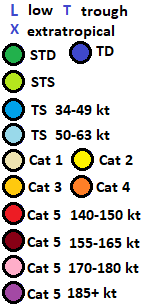
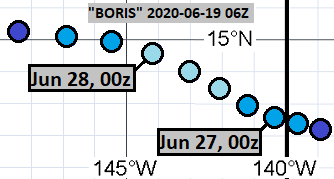

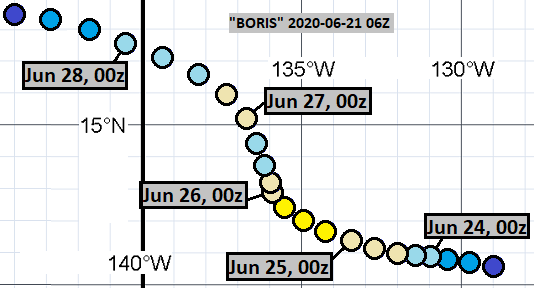
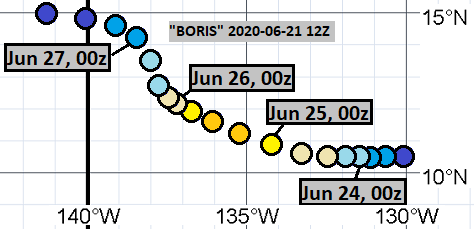
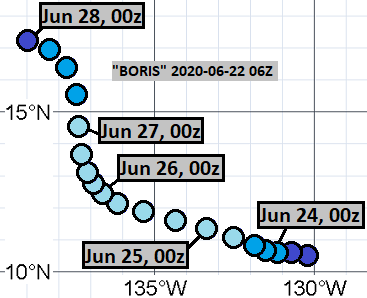
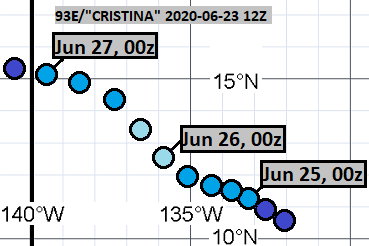
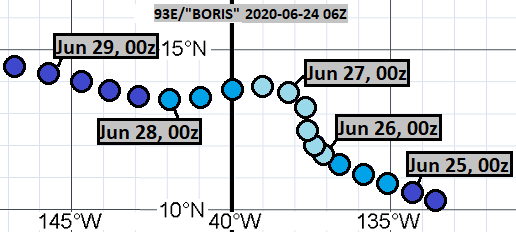


Comments
Post a Comment